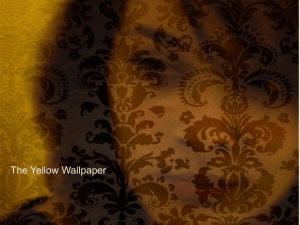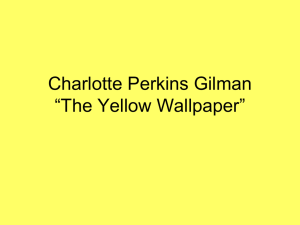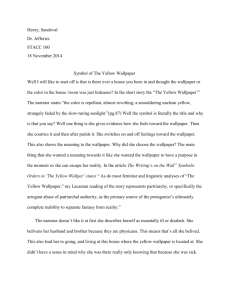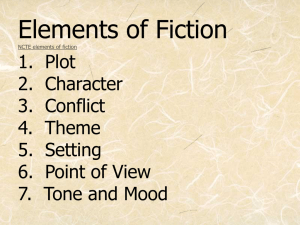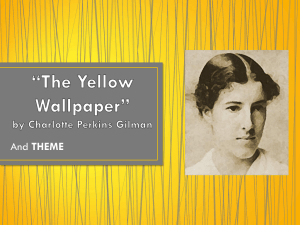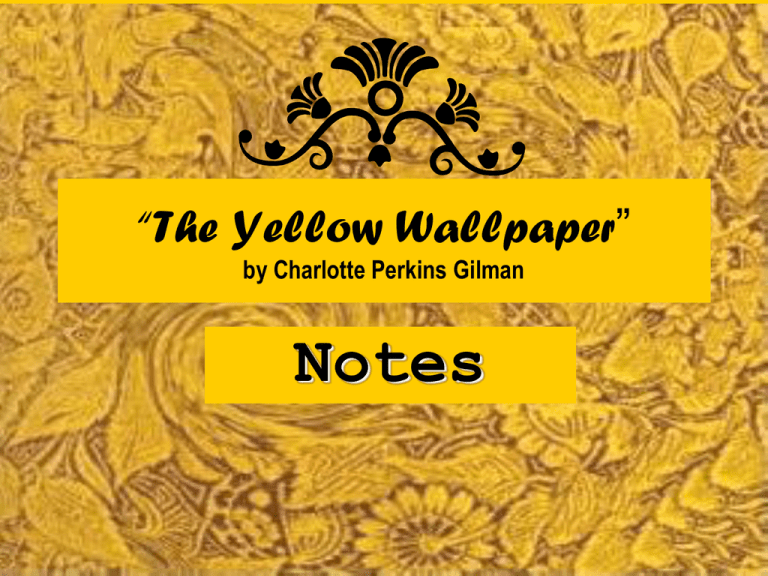
“The Yellow Wallpaper”
by Charlotte Perkins Gilman
Notes
Setting: Victorian Era
Late 1880s
Queen Victoria
1819 - 1901
This is
information
about the
SOCIAL context
of the short
story.
• A woman’s role =
wife and mother
• Women could not vote or
own property
• Women were to be “pure,
pious, domestic and
submissive.”
Victorian Era
This is
information
about the
SOCIAL context
of the short
story.
• Women could
• The Feminist
not live on
movement had
their own;
just begun as a
their husbands
radical, fringe
or fathers
ideology, largely
served as
dismissed by the
their
mainstream.
guardians
Victorian Women:
•Queen Victoria herself said:
"I am most anxious to enlist everyone who can
speak or write to join in checking this mad,
wicked folly of 'Women's Rights', with all its
attendant horrors, on which her poor feeble sex
is bent, forgetting every sense of womanly
feelings and propriety. Feminists ought to get
a good whipping. Were woman to 'unsex'
themselves by claiming equality with men, they
would become the most hateful, heathen and
disgusting of beings and would surely perish
without male protection."
Charlotte Perkins Gilman:
Not a ‘typical’ Victorian lady
This is
information
about the
PERSONAL
context of the
WRITER of this
short story and
the SOCIETY in
which she lived.
• Gilman believed in women’s rights
• Her own experiences were similar
to those of the “The Yellow
Wallpaper”,narrator
• Gilman believed that women must
exercise their intellect or go mad
• The story, “The Yellow Wallpaper”,
was set in the Victorian era, and
the story’s theme was contrary to
the established beliefs of the
period.
Is the narrator of “The Yellow Wallpaper”,
physically or mentally ill?
• The narrator has recently given birth;
she may be suffering from post-partum
depression
• The narrator mentions that she has been diagnosed
with “A slight hysterical tendency,” and was being
treated as most women of her time would be: with
the Rest Cure.
This is
information
about the
PERSONAL
context of the
CHARACTER
in this short
story.
The Rest Cure
This is
information
about the
SOCIAL context
of the short
story.
• This cure was advocated
strongly by a nationally (in
the USA) recognized
neurologist of the time, Dr.
Silas Weir Mitchell.
• His Rest Cure called for
complete rest, coerced
feeding and isolation.
Let’s review what we know
relating to ‘The Yellow
Wallpaper’
• Write down:
• 3 things about the society in which this
story is set (social context)
• 2 things relating to a personal context
• 1 question you still have
The Rest Cure – for Hysteria
• The treatment prescribed by Dr. Weir Mitchell for the
cure of Hysteria involved four steps:
• 1) extended and total bed rest;
• 2) isolation from family and familiar
surroundings;
• 3) overfeeding, especially with cream, on the
assumption that increased body volume created
new energy;
• 4) massage and often the use of electricity for
"hysterical paroxysm", (aka orgasm).(see next
slide for more details)
Hysteria Treatment
• Patients diagnosed with female hysteria would
sometimes undergo "pelvic massage" —
manual stimulation of the woman's genitals by
the doctor to hysterical paroxysm
• (Yes, the first vibrators were
medical devices only; they
were later approved for sale to
the general public as healthenhancement devices.)
• More info. on treating hysteria with
the kind of expertise that only
physicians seemed to have:
http://www.explorehistoricalif.com/hysteria.html
What is Hysteria?
This is
information
about the
CULTURAL
context of the
short story.
• Hysteria was a broad diagnosis, assigned to
women who displayed too much emotion or
demanded too much attention.
• The word itself derives from “hystera,” Greek for
uterus, and ancient doctors attributed a number
of female maladies to a starved or misplaced
womb.
• Hippocrates built on the theory; marriage was
among his recommended treatments.
Hysteria
What context
does this
information
fulfill?
• In the Victorian era, women were
discouraged from work and
over-stimulation.
• Hysteria’s nature was
questionable, and many believed
women faked illness to gain
attention.
Hysteria in pre- 20th
Century society
• The Rest Cure was both a
treatment and a
punishment. Why?
• A: Most women disliked
being placed on rest, and
were unlikely to become
“hysterical” again.
Analysis & Quotes
Narrative Style
Unreliable narrator
Style of prose narration becomes
breathless, manic
Does the narrator go insane or does
she maintain her sanity by
interacting with the only stimulus
she has—the wallpaper?
What could these quotes about
the house be suggesting?
• haunted house…that would be asking
too much of fate!
• And why has it stood so long
untenanted?
• It is quite alone
• there is something strange about the
house—I can feel it.
The narrator is ‘alone … isolated … haunted … ‘
so these quotes show the house is symbolic of
her.
These words are typical of Gothic literature – they
help to foreshadow the terror which will follow.
The House…
• In Victorian times, insane relatives would
have been kept hidden away in an
attic.
• Note how she mentions fate, as if something is going
to happen to her: “but that would be asking too
much of fate!”
Pablo Picasso,
Mad Woman with Black Cat
Important Themes & Ideas
Patriarchy & the subjugation of women in
marriage (note how John patronizes her)
Childlike dependency of
women
Superiority of physicians
Need for work, intellectual
stimulation and opportunities
to express creativity.
The Wallpaper
Read the following quotes
about the wallpaper:
It is stripped off—the paper—
in great patches all around the
head of my bed, about as far
as I can reach, and in a great
place on the other side of the
room low down.
I never saw a worse paper in
my life.
What is the Wallpaper doing to her?
The Wallpaper
sprawling flamboyant patterns
committing every artistic sin.
The color is repellent, almost
revolting; a smouldering unclean
yellow, strangely faded by the
slow-turning sunlight.
It is a dull yet lurid orange in
some places, a sickly sulphur tint
in others.
What is the Wallpaper doing to
her?
The Wallpaper
• This paper looks to me as if it knew
what a vicious influence it had!
• There is a recurrent spot where the
pattern lolls like a broken neck and
two bulbous eyes stare at you upside
down.
• I never saw so much expression in an
inanimate thing before, and we all
know how much expression they have!
• What is the Wallpaper doing to her?
The Wallpaper
What is the wallpaper doing to her?
• The wallpaper is stimulating her
senses, as she has nothing else to do
• All the emotional and intellectual
stimulation she has comes from the
wallpaper
The Wallpaper
• It is dull enough to confuse the eye in
following, pronounced enough to
constantly irritate and provoke study,
and when you follow the lame
uncertain curves for a little distance
they suddenly commit suicide—
plunge off at outrageous angles,
destroy themselves in unheard of
contradictions.
• Note the violent images and reference to suicide
• What inference can you make about her?
What do these observations
about the Wallpaper tell us?
• “The wall-paper, as I said before, is torn off in spots”
• “Then the floor is scratched and gouged and
splintered, the plaster itself is dug out here and there,
and this great heavy bed which is all we found in the
room, looks as if it had been through the wars.”
She’s not the first to hate it!
The Wallpaper
• Clearly, some other
unhappy person (or
people) have been held
in this room, tearing at
the paper, gouging the
walls, gnawing on the
bed…
Indication of the narrator’s
mental state:
• “I got so angry I bit off a little piece at one corner—but it
hurt my teeth.”
• What does this reveal:
• How does it reveal it?
The wallpaper occupies her mind
• I'm getting really fond of the room in spite of
the wallpaper. Perhaps because of the
wallpaper.
• It dwells in my mind so!
• You think you have mastered it, but just as
you get well underway in following, it turns
a back-somersault and there you are. It
slaps you in the face, knocks you down, and
tramples upon you.
The wallpaper occupies her mind
• It sticks horribly and the
pattern just enjoys it! All those
strangled heads and bulbous
eyes and waddling fungus
growths just shriek with
derision!
– The wallpaper has come alive and
interacts with her! In fact, it is like
another character.
Work vs Rest
• “Personally, I believe that congenial work, with
excitement and change, would do me good.”
• “sometimes fancy that in my condition if I had less
opposition and more society and stimulus”
– What do these quotes reveal about the narrator’s
state of mind?
– A: Clearly, the narrator understands that she needs
activity, rather than isolation and “rest”
Work vs Rest
• “It is so discouraging not to have any
advice and companionship about my
work. When I get really well, John
says we will ask Cousin Henry and
Julia down for a long visit; but he
says he would as soon put fireworks
in my pillow-case as to let me have
those stimulating people about now.”
• What would have happened if the
narrator had had ‘stimulating people’
and ‘advice and companionship’ made
available to her?
Lunacy…
• She stays up at night and
sleeps during the day.
• The word "lunatic" is built on
the Latin word for moon,
luna.
• Lunacy = a form of insanity
characterized by alternating lucid
and insane periods, believed to
be influenced by phases of the
moon.
• Cycles of the moon…
menstrual cycles…more
hysterical woman stuff?
“I didn't realize for a
long time what the thing
was that showed
behind, that dim subpattern, but now I am
quite sure it is a
woman.”
Sensory Stimulation
• “By daylight she is
subdued, quiet. I
fancy it is the pattern
that keeps her so still.
It is so puzzling. It
keeps me quiet by the
hour.”
• Which sense?
Sensory Stimulation
• “There are always new
shoots on the fungus, and
new shades of yellow all over
it.”
• “I cannot keep count of them,
though I have tried
conscientiously. “
• Which sense?
Sensory Stimulation
• It is the strangest yellow,
that wall-paper! It makes
me think of all the yellow
things I ever saw—not
beautiful ones like
buttercups, but old foul,
bad yellow things.
• But there is something else
about that paper— the
smell!
• Which sense?
Sensory Stimulation
• The narrator hears, sees,
touches, tastes and smells the
paper as it comes more alive to
her.
• Make a table of 5 columns,
draw a symbol for each sense
in each column and write in a
quote appropriate to each one.
Who is the woman in the wallpaper?
• Could the woman be the
narrator’s shadow?
• Could it represent the narrator
herself, trapped inside the
wallpaper? (Just as the
wallpaper has trapped the
narrator’s mind.)
Who is the woman in the wallpaper?
• Like the narrator herself,
the woman is trapped
within a suffocating
domestic “pattern”
from which no escape
is possible…however,
she tears off the paper to
free the woman (and
herself.)
Resolution: Victim or Victor?
• “Now why should that man have
fainted? But he did, and right across
my path by the wall, so that I had to
creep over him every time!”
• Fainting is a “feminine” response;
continuing one’s work without
emotion is more “male” (especially in
Victorian times) At the end of this
story there is a role reversal? Why?
A “fainting couch”
Resolution: Victim or Victor?
• “Now why should that man have fainted? But he
did, and right across my path by the wall, so that I
had to creep over him every time!”
– The meaning of the last paragraph
has been the subject of a great
deal of critical debate.
– Some critics see this as a point
where the narrator triumphs over
her husband and the wallpaper.
– Others see this as a point where
the narrator fails since she has
finally been driven insane by the
paper and not escaped the room.
What do you think?
Lucky Last!
•
•
•
•
Your final activity is to:
1) select five examples of text aspects
2) Define them and
3) explain their effect

